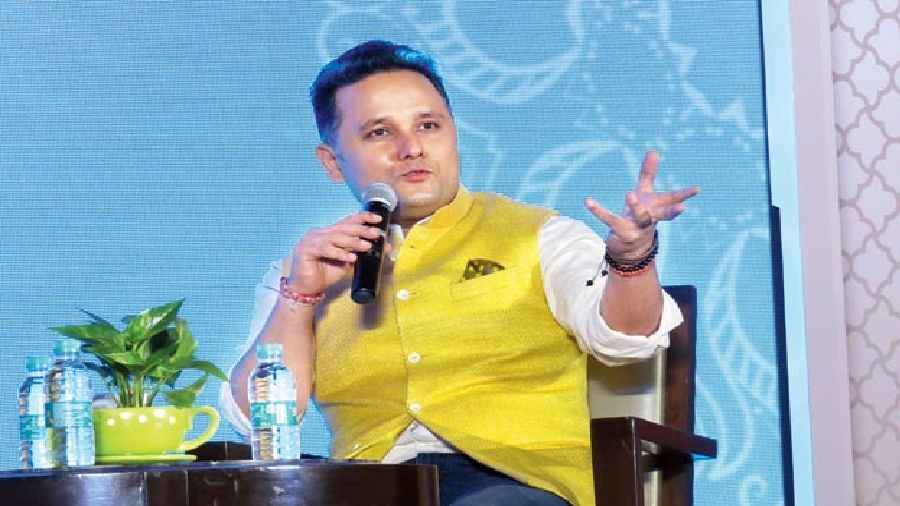Amish Tripathi is a man in a hurry. So much so that he has put together a team of writers to help him in conducting research and composing first drafts of some of his projects. “Lord Shiva has blessed me with too many ideas for one lifetime,” he tells t2 when we settle down for a chat on the sidelines of the launch of his latest venture at a star hotel in Mumbai — a documentary for Discovery+ titled Legends of Ramayana. The best-selling author, whose day job is as the director of Nehru Centre, London, has forayed into the digital space for the first time as the narrator of the show which has started streaming.
Why did you agree to come on board for the project?
The Ramayana needs to be presented in a way that people, including those abroad, understand the depth of the epic. Western channels or film-makers have made documentaries out of our epics but sometimes foreigners do not do so respectfully. But Discovery has the perfect balance of professionalism and sincerity.
How was the shooting experience?
The crew was so big that it seemed like we were shooting a film! They were such perfectionists that sometimes I thought they were crazy. For one shot on the seaside, they wanted me to deliver a dialogue right at the moment when the wave would break on the shore behind me. The sun was beating down. Yet they did it repeatedly till they got the perfect shot.
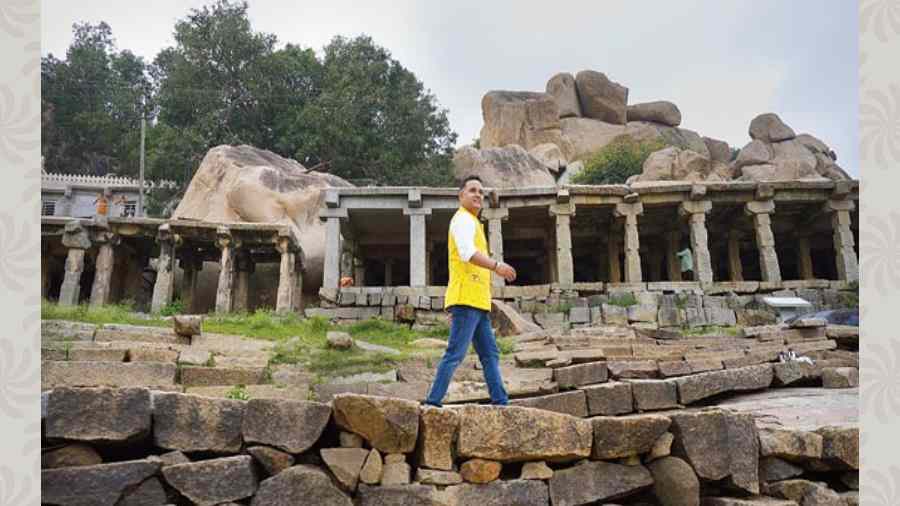
At Chakratirtha, Hampi

A cave near Chintamani temple, Anegundi, Karnataka. Legend has it that this was the monkey kingdom of Kishkindha where Rama first met Hanuman

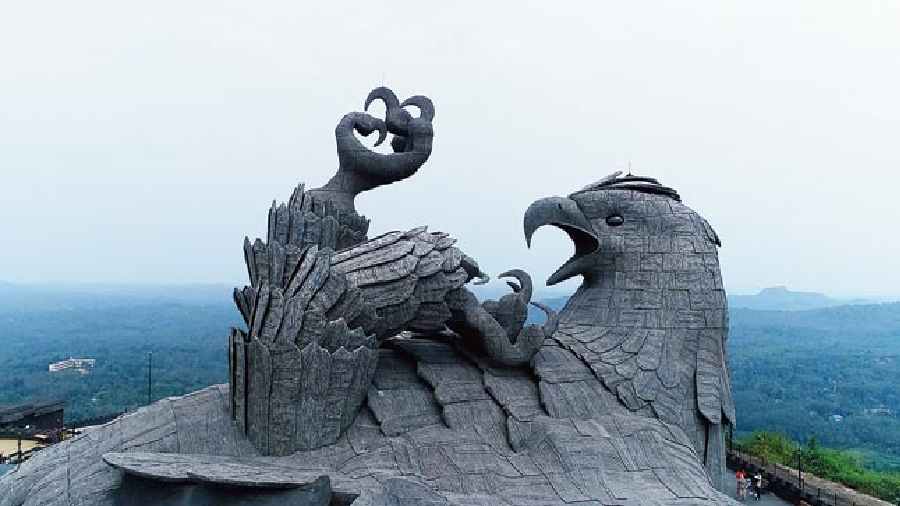
Jatayu Nature Park, Kerala
How long is the series? Where did you go?
There are three episodes, each episode of 45-50 minutes. We had two schedules — of two weeks in India and one week in Sri Lanka. I am essentially following in the footsteps of Lord Rama. In the first episode, the journey takes me from Ayodhya, Prayagraj (Allahabad), Chitrakoot to Nasik. The second will cover from Nasik to Hampi to Rameswaram. Then the third part has various parts of Sri Lanka and comes back to Ayodhya.
Are there things you found out about the epic in course of shooting the series?
Since it is a documentary, we showed whatever we found proof of. I had read of gupt Godavari, an underground river in Chitrakut mentioned by Valmiki but I had not been to Chitrakut. Discovery commissioned a hydrogeologist who found a river that flowed into a cave. I am a bit claustrophobic yet I went into the cave for the shoot.
You have heard of Ramsetu. (Also known as Adam’s Bridge, it is a chain of natural limestone shoals, between Rameswaram Island, off the south-eastern coast of Tamil Nadu, and Mannar Island, off the north-western coast of Sri Lanka.) In Rameswaram, the research team found stones originating in coral reefs. These stones are so strong that you can walk on them yet they are so light that they float in water! They showed me a church built of these stones. So it is strong enough to be load-bearing.
What kind of people did you speak to?
We met a community in Chhattisgarh called Ramnami. Centuries ago, their ancestor was not allowed into a temple. To prove that his devotion was no less than others, he tattooed the name of Lord Rama in Devnagari script on every inch of his body, thus turning his body into a temple. The tradition is carried on by his descendants who are the most devout of disciples.
There is a sect in Rajasthan, the Manganiyar Muslims. They are namazi Muslims, who offer namaz five times a day but their vocation is singing devotional ballads dedicated to Lord Rama. Such beautiful syncretism is possible only in India!
What about your other projects?
The fourth book of the Ramachandra series, War of Lanka, is ready. It is being edited and will be released soon. My publisher Westland has shut down, so a new agreement has been drawn up with another publisher.
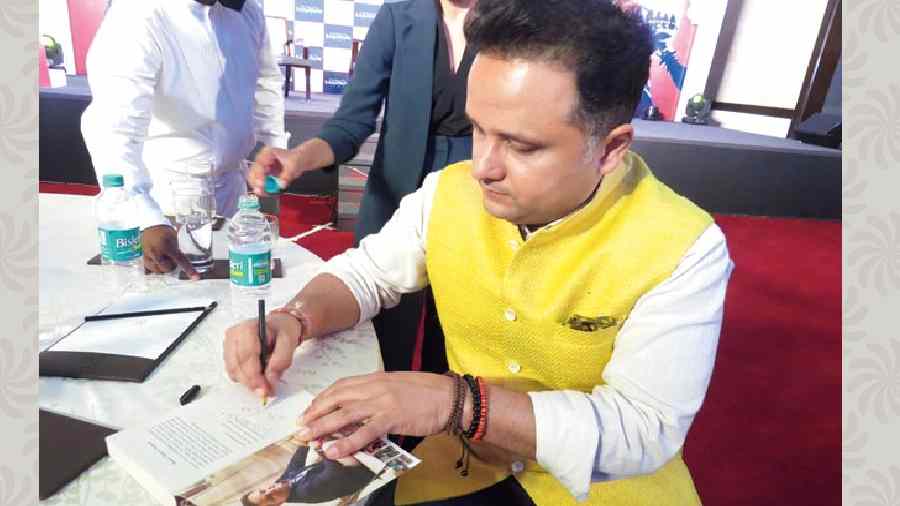
Amish Tripathi autographs a book at the launch of the web show in Mumbai. Picture by Sudeshna Banerjee
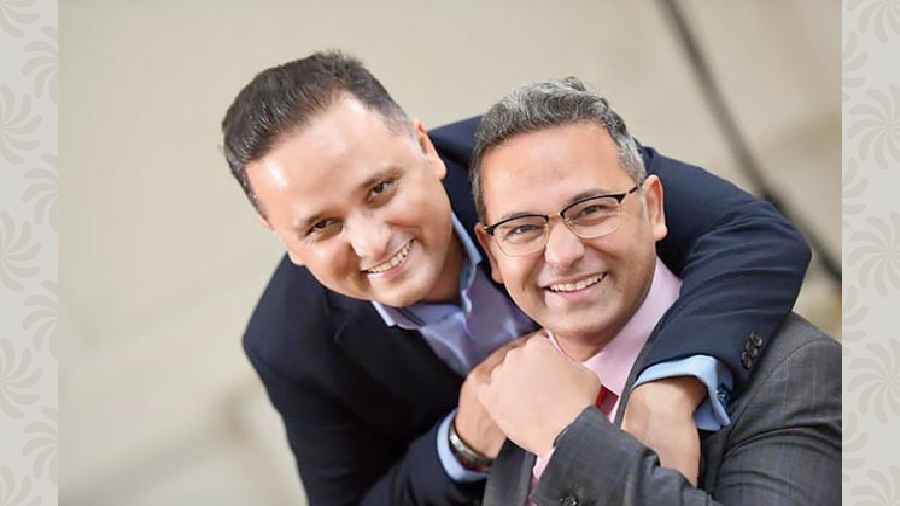
Amish Tripathi with his twin brother
Where will War of Lanka end?
War of Lanka ends with the death of Ravana and the return of Lord Rama to Ayodhya, where the traditional Ramayan ends. I aim to write a fifth book some time later to give a sense of conclusion. This will be a multi-linear narrative, much like the Japanese movie Rashomon (directed by Akira Kurosawa) where a murder is recounted from various points of view. Every perspective sounds equally credible. A story runs on the shoulders of the characters. The three principal characters in Ramayana are Lord Rama, goddess Sita and Ravan but it essentially follows Rama’s journey.
You understand each character if you understand their motivations. All of them come to the same point, the incident that forces them together — the kidnapping of Sita ma. It makes you understand the story that much deeper. So all three earlier books, Ram: Scion of Ikshvaku, Sita: Warrior of Mithila and Ravan: Enemy of Aryavarta, ended at that point. From there onwards, it’s a common narrative in War of Lanka.
At the recent Kolkata Literary Meet, you mentioned a new-age fiction project on the anvil.
Yes, it is set in London in the modern day and has elements of time travel and gaming. It is very different from what I am used to. I am quite excited by it. One should jump out of one’s comfort zone sometimes. It will be a fictional series with a central character.
Is this a result of your taking up residence in London?
Yes. There were some ideas which came together with my London stay (as director of Nehru Centre).
Every experience drives creativity, everything triggers ideas. That’s why I like to experience new things, meet different people from diferent cultures, even if I am only listening.
What news of the film that was supposed to be made based on the Legend of Suheldev?
The script is ready. We are moving to the next step. You will hear an announcement soon. It will be produced by my Immortal Studios and two partners, Wakaoo Films and Casa Media.
Karan Johar had the rights to your book. What happened to that?
He had the rights to my Shiva trilogy. That didn’t work out for various reasons. He is still a friend, of course. The rights are back with me and that has been contracted to Roy Price, a big Hollywood producer (Amazon Video founder and Emmy and Globe series-winning studio executive), Shekhar Kapur, an Oscar-winning film-maker, and Suparn Varma, the creator of The Family Man, a most successful OTT series. So a high-quality team has been put together to make the Shiva trilogy.
In an earlier interview, you had mentioned that you have ideas based on Egyptian, Greek and Celtic mythologies as well.
My biggest problem is I have too many ideas for one lifetime. I am working on setting up Writers Centre and developing something directly into an OTT series. I am already involved with this documentary, the Shiva trilogy OTT series, the Suheldev movie, War of Lanka, another non-fiction book that I am planning on the beauty of idol worship, another Immortal Writers’ Centre (his team of writers) non-fiction book… and I am developing a fresh OTT series subject in the historical space as well. So my plate is full. This is besides my Nehru Centre work.
Are you interested in The Mahabharata as well?
Yes, that will also come. As I said, Lord Shiva has blessed me with too many ideas! (Laughs)
In your account, the reason for Rama’s exile is a penance for using Asurastra while the more conventional story involves Kaikeyi and Dasaratha. When writing fictional accounts based on Indian mythologies, are you not worried about accusations of distortion if you veer from the popular notion?
I have been writing for 12 years. Have you ever heard a controversy around me? There are various versions already. The Jain version, the Buddhist version, the Ananda Ramayana — all these have different reasons for Rama’s exile. I feel often controversies are created as a marketing strategy. It doesn’t matter if you have written a different version, the key thing Indians look at is whether you have written it with respect. They can sense it in a book or a film. Look at Rajamouliji’s Baahubali. A key scene is where he breaks the Shivaling from the base and carries it on his shoulder to a waterfall. It is a rudraavishekam. If you read it in the script, you would shudder at the thought of breaking a Shivalinga. But if you see in the film, it is one of the most powerful emotional scenes. Indians are intuitively very liberal. They just see if there is respect. I am devoted to the gods I write on. So there is no controversy.
Would you say Indians are increasingly subscribing to a more unipolar reading of The Ramayana?
I would disagree. The practice of seeing Ravan as more demonic began with the devotional Ramayanas about 1,000 years ago. Kamba Ramayan dates around that period. Before that, the anciant versions, including Valmiki’s Ramayana, saw things in a nuanced way. Valmiki is very clear that Rama was human. Seeing things in black and white is not the Indian way. That is more the Western or the Middle Eastern way. There is no permanent heaven and hell for us. That’s the way not just Hinduism but all religions are practised in India. Only an Indian Muslim will say: ‘Sharab peene de masjid mein baith kar ya woh jagah bata jahan Khuda nahi’ (Mirza Ghalib). I’d argue we are seeing a revival of the ancient way now.
Yes, there are a lot of debates but debates happen when there are multiple stories. Earlier there were no debates. All the versions of the last 1,000 years had a demonic Ravan. And if there is a churn, poison comes out too but overall, I think, things are moving in a positive direction.
Is the shelf on mythology getting too crowded at the bookstores?
There is no such thing as crowding. The more stories that are available on our mythologies the better (smiles).
Channel speak
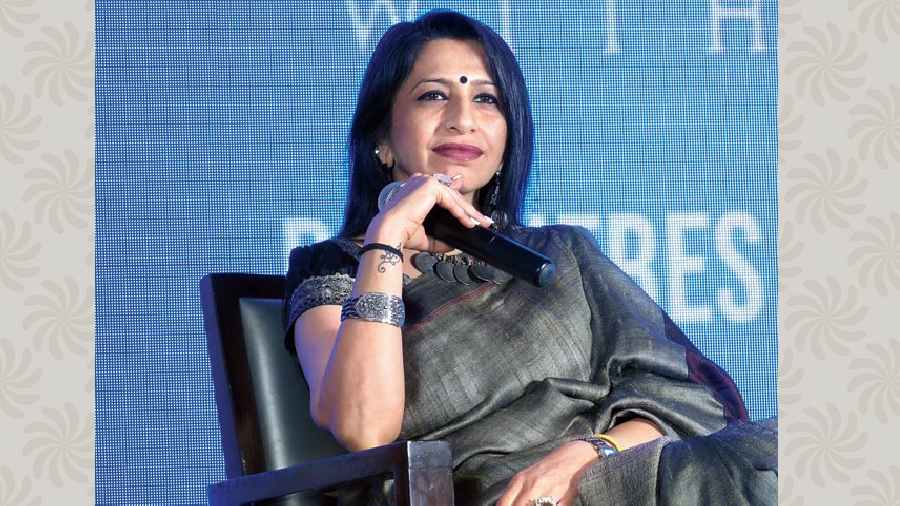
Megha Tata, managing director, south Asia, Discovery Communications
Given that Discovery is known for factual content, how did you approach a mythological subject and integrate it to your ethos?
One of the things we were clear about is we have to see it through the Discovery lens. There has to be credibility and authenticity. The team spent a lot of time in understanding the nuances of what we want to cover in the show. Everyone knows the story of Ramayana. We were trying to bring a fresh perspective — connecting the dots in the journey of Lord Rama in the real world and make it relevant for our viewers.
What genres are working best on your OTT platform?
Mythology is a new genre and we have to see how this works.
What are working very well are crime and thriller, besides adventure and the military. Shows like Money Mafia and Anni: The Honeymoon Murder are doing very well. We have some interesting shows lined up in that space. The international markets of Discovery+ have picked some of our shows as well, like Say Yes to the Dress and Into the Wild with Bear Grylls, featuring Prime Minister (Narendra) Modi.

